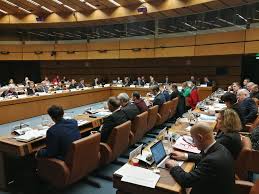- Courses
- GS Full Course 1 Year
- GS Full Course 2 Year
- GS Full Course 3 Year
- GS Full Course Till Selection
- CSAT
- 5 LAYERED ARJUNA Mentorship
- Public Administration Optional
- Online Program
- GS Recorded Course
- NCERT Batch
- Polity Module Course
- Geography Module Course
- Economy Module Course
- AMAC Module Course
- Modern India, Post Independence & World History Module Course
- Environment Module Course
- Governance Module Course
- Science & Tech. Module Course
- International Relations and Internal Security Module Course
- Disaster Management Module Course
- Ethics Module Course
- Essay Module Course
- Current Affairs Module Course
- ABOUT US
- OUR TOPPERS
- TEST SERIES
- FREE STUDY MATERIAL
- VIDEOS
- CONTACT US
Minilateralism: A Rising Force in Global Governance
Minilateralism: A Rising Force in Global Governance
22-07-2024
Recently, the rise of Chinese aggression in the Indo-Pacific region has prompted the formation of the ‘Squad’ highlighting the growing importance of “minilateralism.”
- A squad is a multilateral group consisting of the US, Japan, Australia, and the Philippines.
What is Minilateralism?
- About: Minilaterals are informal, focused initiatives involving a small group of states (usually three or four) with shared interests. These collaborations aim to address specific threats or issues within a limited timeframe. They lack a permanent or formal structure, and outcomes are voluntary and non-binding.
-
Reasons for Rise:
- The changing global order and threats challenge the relevance of multilateral frameworks in resolving local conflicts.
- Inconsistent US global leadership and a multipolar world have exposed cracks in multilateral organizations like the UN Security Council and WTO.
- Global problems often have regional variations, and minilaterals can tailor solutions to specific challenges.
-
Contrast with Multilateralism: Multilateralism involves formal efforts by multiple states to build trust and avoid conflict through institutionalized rules and norms. Multilateral frameworks emphasize broad participation, unlike the focused nature of minilaterals.
-
Key Differences:
- Minilateralism vs. Multilateralism: Multilateralism involves formal agreements and broader participation among states to build trust and avoid conflict. Minilaterals are more flexible and focused on specific issues.
- Minilateralism vs. Regional Organizations: Regional organizations address a wide range of issues through formal structures, while minilaterals are ad hoc coalitions formed to address specific, often urgent, concerns.
Squad and QUAD
-
Formation and Role of the 'Squad': The "Squad" (US, Japan, Australia, Philippines) was formed to enhance maritime security in the South China Sea and counter Chinese aggression.
-
Comparison with the Quad: The Quad (US, Japan, Australia, India) focuses on broader Indo-Pacific security, while the "Squad" addresses specific concerns in the South China Sea.
What are the Advantages of Minilaterals?
-
Bypass Stagnation: Allow countries to circumvent stalled multilateral frameworks and address pressing issues.
- For example, the Bangladesh-Bhutan-India-Nepal (BBIN) Motor Vehicles Agreement (MVA) was conceived even the SAARC failed to facilitate a similar initiative.
-
Flexibility: Offer a modular approach, enabling quick formation and adaptation to changing circumstances.
- This flexibility is evident in trade agreements like the Trans-Pacific Partnership (TPP) and the Regional Comprehensive Economic Partnership (RCEP), which were concluded as minilateral agreements.
-
Rapid Decision-Making: Voluntary and non-binding nature facilitates swift decision-making.
-
Targeted Partnerships: Enable the creation of issue-specific partnerships and strategic alliances, especially in regions like the Indo-Pacific.
- Examples include the Quadrilateral Security Dialogue (Quad) and the Trilateral Cooperation and Oversight Group (TCOG), which address regional security concerns more effectively than larger, more formal organisations.
-
Rapid Response to Crises: Regional minilateral forums can promptly come to the rescue of affected nations.
- For example, India has sent the Indian Naval Ship (INS) Kesari, carrying food items and medical assistance teams, to countries in the southern Indian Ocean to deal with Covid-19 pandemic as part of a Mission Sagar initiative.
What are the Issues Associated With Minilateralism?
- Minilaterals can lead to forum shopping, undermining critical international organisations, and reducing accountability in global governance.
- By promoting voluntary commitments rather than legally binding ones, minilaterals may weaken the enforcement of international norms and standards.
- Preference for minilaterals may reduce the incentive for countries to engage with multilateral frameworks.
- This can impact the relevance and effectiveness of organizations like the World Health Organization (WHO) and the United Nations Children's Fund (UNICEF), which rely on multilateral cooperation for their programs.
- Minilateral success often depends on leadership, political will, and bilateral relations among members.
- Changes in political leadership or strained relations can derail minilateral initiatives, as seen with the initial failure of the Quad due to leadership changes in Japan and Australia.
- Minilateral alliances may have negative impacts on countries not part of the negotiations, reducing their incentive to engage with existing multilateral efforts.
- This was observed in the Doha trade negotiations, where the focus on plurilateral initiatives hindered broader multilateral progress.
Way Forward
To harness the benefits of minilateralism while mitigating its risks:
-
Integration with Multilaterals: Minilaterals should complement, not replace, the work of larger organizations.
-
Forward-Looking Perspectives: Anticipate the impact of minilaterals on regional security and strategic outcomes.
- Ensuring plurality and diversity in minilateral institutions can help accommodate different groupings' needs, and address issues of shared interest.
- For example, under Security and Growth for All in the Region (SAGAR) India seeks to deepen economic and security cooperation with its maritime neighbours and assist in building their maritime security capabilities.
- Clear Objectives: Define concrete and measurable objectives to maximize effectiveness.
Conclusion
The rise of the "Squad" and similar minilateral groupings reflects a strategic adaptation to the evolving geopolitical landscape. By integrating minilaterals with multilateral frameworks, embracing a forward-looking perspective, and setting clear objectives, countries can leverage this tool effectively for addressing shared challenges and promoting global cooperation.



